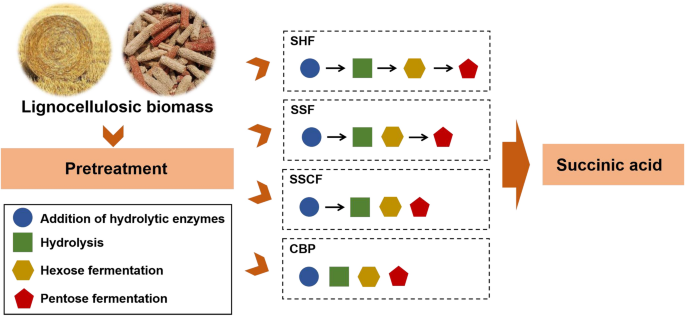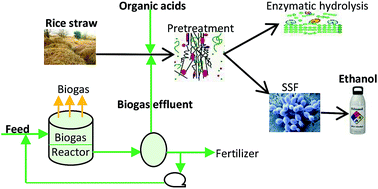Features of promising technologies for pretreatment of lignocellulosic biomass. Dilute sulfuric acid is best for pretreatment of lignocellulosic biomass. Lignocellulosic biomass has been recognized as a promising feedstock for the fermentative production of biofuel. Can soda cooking of spruce be considered. Ozone pretreatment is a great option for lignin content reduction in lignocellulosic biomass. Chemical pretreatment dilute acid pretreatment: Many factors, like lignin content, crystallinity of cellulose, and pretreatments have as a goal to improve the digestibility of the lignocellulosic biomass. Lignocellulosic biomass represents a rather unused source for biogas and ethanol production. Lignocellulosic biomass is a renewable and sustainable energy resource for carbon that is readily available in the environment.
However, it has certain disadvantages such as production of inhibitory compounds and corrosion of reaction vessel (lee and jeffries 2011). Recent insights into lignocellulosic biomass pyrolysis: 5.3 pretreatment of lignocellulosic biomass. Pretreatment effect on the bioethanol production. The objective of this review is to discuss the various pretreatment strategies currently in use and provide an overview of their utilization for the isolation of. When the word carbohydrate is used, i typically think of the carbohydrates in food. Due to its low cost, pretreatment of lignocellulosic biomass through sulfuric acid is a conventional method.

Lignin can be redistributed into a solution, and lignin and carbohydrates can be.
Acid and high temperature is considered where hydrolysis reactions are carried out. Sulfuric acid is the most applied acid while other acids such as hcl and nitric acid also have been reported. Lignin can be redistributed into a solution, and lignin and carbohydrates can be. Lignocellulosic biomass, the most abundant renewable bioresource, is mainly composed of three major biopolymeric components: Lignocellulosic biomass represents a rather unused source for biogas and ethanol production. Pretreatment effect on the bioethanol production. Pretreatment and enzymatic hydrolysis of lignocellulosic biomass by. Lignocellulosic biomass is the most economical and highly renewable natural resource in the world. Can soda cooking of spruce be considered. Lignocellulosic biomass (lcb) is the most abundantly available bioresource amounting to about a global yield of up to 1. The hydrolysate obtained after washing the pretreated biomass contained 32.55 g/l of xylose, 2.74 g/l of glucose and low concentrations of inhibitors. Lignocellulose refers to plant dry matter (biomass), so called lignocellulosic biomass. For the pretreatment of lignocellulosic biomass, different acids have been applied on industrial scale such as phosphoric acid, hydrochloric acid, nitric acid, and dilute sulphuric acid. Pretreatment lignocellulosic biomass is attractive feedstock because of affordable price and high. 5.3 pretreatment of lignocellulosic biomass.
Can soda cooking of spruce be considered. Cellulose in this review, we will narrow down biochemical conversion by using cellulose solvents. A critical review on pretreatment, characterization, and products upgrading.

Due to its low cost, pretreatment of lignocellulosic biomass through sulfuric acid is a conventional method.
Lignocellulosic biomass has been recognized as a promising feedstock for the fermentative production of biofuel. Sem and xrd sowed that lignin and wax was removed successfully and. Dilute sulfuric acid is best for pretreatment of lignocellulosic biomass. Acid pretreatment involves the use of concentrated and diluted acids to break the rigid structure of the lignocellulosic material. 5.3 pretreatment of lignocellulosic biomass. For the pretreatment of lignocellulosic biomass, different acids have been applied on industrial scale such as phosphoric acid, hydrochloric acid, nitric acid, and dilute sulphuric acid. Many factors, like lignin content, crystallinity of cellulose, and pretreatments have as a goal to improve the digestibility of the lignocellulosic biomass. A continuous reactor for the lignocellulosic biomass pretreatment using dilute sulfuric. Pretreatment of lignocellulosic biomass using microorganisms: Can soda cooking of spruce be considered. It is composed of carbohydrate polymers (cellulose, hemicellulose), and an aromatic polymer (lignin). Pretreatment lignocellulosic biomass is attractive feedstock because of affordable price and high. Chandel and silvio silvério da silva. Recent insights into lignocellulosic biomass pyrolysis: A critical review on pretreatment, characterization, and products upgrading.
Pretreatment lignocellulosic biomass is attractive feedstock because of affordable price and high. The hydrolysate obtained after washing the pretreated biomass contained 32.55 g/l of xylose, 2.74 g/l of glucose and low concentrations of inhibitors. In vitro digestibility of biomass is enhanced by the. Lignocellulosic biomass is the most economical and highly renewable natural resource in the world. Removal of xylan in lignocellulosic biomass brought the separation of complex structure to easily access the cellulose degrading enzymes. A critical review on pretreatment, characterization, and products upgrading.

Lignin can be redistributed into a solution, and lignin and carbohydrates can be.
Many factors, like lignin content, crystallinity of cellulose, and pretreatments have as a goal to improve the digestibility of the lignocellulosic biomass. In vitro digestibility of biomass is enhanced by the. 5.3 pretreatment of lignocellulosic biomass. Lignocellulosic biomass (lcb) is the most abundantly available bioresource amounting to about a global yield of up to 1. Lignocellulosic biomass represents a rather unused source for biogas and ethanol production. A continuous reactor for the lignocellulosic biomass pretreatment using dilute sulfuric. To treat lignocellulosic biomass, concentrated acids are also used. Recent insights into lignocellulosic biomass pyrolysis: Lignocellulosic biomass substrate structure, representing plant structure and lignin, cellulose most pretreatment methods for lignocellulosic ad processes require high amounts of energy and chemical input in order to properly work, but they also create detrimental impacts 47. Dilute sulfuric acid is best for pretreatment of lignocellulosic biomass. Chandel and silvio silvério da silva. Pretreatment effect on the bioethanol production. Acid and high temperature is considered where hydrolysis reactions are carried out. Lignocellulosic biomass has been recognized as promising feedstock for biofuels production. However, it has certain disadvantages such as production of inhibitory compounds and corrosion of reaction vessel (lee and jeffries 2011).
Pretreatment of lignocellulosic biomass with sulfuric acid is a conventional method because of its low cost pretreatment of lignocellulosic biomass. To treat lignocellulosic biomass, concentrated acids are also used.

The objective of this review is to discuss the various pretreatment strategies currently in use and provide an overview of their utilization for the isolation of.

A continuous reactor for the lignocellulosic biomass pretreatment using dilute sulfuric.

Pretreatment of lignocellulosic biomass with sulfuric acid is a conventional method because of its low cost.

Chandel and silvio silvério da silva.

The hydrolysate obtained after washing the pretreated biomass contained 32.55 g/l of xylose, 2.74 g/l of glucose and low concentrations of inhibitors.

A continuous reactor for the lignocellulosic biomass pretreatment using dilute sulfuric.
Acid and high temperature is considered where hydrolysis reactions are carried out.

Chandel and silvio silvério da silva.
Hence, the pretreatment of lignocellulosic biomass, prior to other treatment methods, is an essential step in order to increase cellulose and hemicellulose lignocellulosic biomass derivable alditols (isosorbide, erythritol, mannitol, sorbitol, xylitol, arabinitol), aldaric acids (glucaric acid, xylaric acid.

3 billion tons per year.

However, it has certain disadvantages such as production of inhibitory compounds and corrosion of reaction vessel (lee and jeffries 2011).

Ozone pretreatment is a great option for lignin content reduction in lignocellulosic biomass.
The individual components can swell, depending on the organic solvent or acid used.

Acid pretreatment involves the use of concentrated and diluted acids to break the rigid structure of the lignocellulosic material.

5.3 pretreatment of lignocellulosic biomass.

Each pretreatment has its own effect(s) on the cellulose.
Recent insights into lignocellulosic biomass pyrolysis:

Chandel and silvio silvério da silva.

3 billion tons per year.

Lignocellulosic biomass is a renewable and sustainable energy resource for carbon that is readily available in the environment.

Lignocellulosic biomass (lcb) is the most abundantly available bioresource amounting to about a global yield of up to 1.

Chemical pretreatment dilute acid pretreatment:

5.3 pretreatment of lignocellulosic biomass.

Pretreatment and enzymatic hydrolysis of lignocellulosic biomass by.
Lignocellulosic biomass has been recognized as promising feedstock for biofuels production.

Lignocellulosic biomass (lcb) is the most abundantly available bioresource amounting to about a global yield of up to 1.
Sulfuric acid is the most applied acid while other acids such as hcl and nitric acid also have been reported.
Lignocellulosic biomass, the most abundant renewable bioresource, is mainly composed of three major biopolymeric components:

The hydrolysate obtained after washing the pretreated biomass contained 32.55 g/l of xylose, 2.74 g/l of glucose and low concentrations of inhibitors.

The individual components can swell, depending on the organic solvent or acid used.

Sem and xrd sowed that lignin and wax was removed successfully and.

A continuous reactor for the lignocellulosic biomass pretreatment using dilute sulfuric.

Features of promising technologies for pretreatment of lignocellulosic biomass.

3 billion tons per year.

Acid pretreatment involves the use of concentrated and diluted acids to break the rigid structure of the lignocellulosic material.